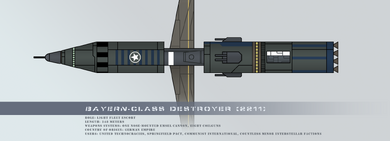MrSomewhereSomeplace (talk | contribs) No edit summary Tag: Visual edit |
MrSomewhereSomeplace (talk | contribs) No edit summary Tag: Visual edit |
||
| Line 7: | Line 7: | ||
*'''Country of Origin:''' [[German Empire]] |
*'''Country of Origin:''' [[German Empire]] |
||
| − | *'''Users:''' [[Springfield Pact]], [[United Technocracies of Man]], Countless minor factions |
+ | *'''Users:''' [[Springfield Pact]], [[United Technocracies of Man]], Countless minor interstellar factions |
| − | The ironically-named German Deep Space Fleet always believed in quality over quantity. German ships tended to be bigger, have more powerful reactors (and consequently weapons systems) and had more precise targeting systems than their [[American]] and [[Soviet]] counterparts. German ships had more space for crewmen, were supplied with better-quality food and the Germans were the first to equip their ships with energy shielding. However, the German Deep Space Fleet never had the operational range of the Imperial Navy or the numbers of the Red Navy, which would cripple it during the [[Collapse]]. |
+ | The ironically-named German Deep Space Fleet always believed in quality over quantity. German ships tended to be bigger, have more powerful reactors (and consequently weapons systems) and had more precise targeting systems than their [[American]] and [[Soviet Union|Soviet]] counterparts. German ships had more space for crewmen, were supplied with better-quality food and the Germans were the first to equip their ships with energy shielding. However, the German Deep Space Fleet never had the operational range of the Imperial Navy or the numbers of the Red Navy, which would cripple it during the [[Collapse]]. |
But German war planners predicted this issue and planned accordingly, calling for the design of ships with much greater speed and operational ranges than what was available to the fleet at the time. Despite the crumbling of the German Reich, the Kaiser and the Reichstag understood the importance of a stronger navy to defend Germany's remaining interstellar assets. The ''Bayern''-class destroyer and ''Hamburg''-class battleship were the result of this reform: two ships that would complement one another in a faster new fleet that can challenge the Imperial and Red navies anywhere in the galaxy. The ''Bayern'' was equipped with a brand-new feature that would become a staple in interstellar warfare in the centuries to come: radiator fins. This mitigated the issue of overheating and allowed the ''Bayern'' to operate longer than its opponents, a key feature in the few German victories during the Collapse. In typical German style, the ''Bayern'' was armed with one nose-mounted [[EMSEL]] cannon and eight coilguns, allowing it to play the role of point defense or ship assault. Imperial and Soviet fears of German buildup accelerated the arms race between the three superpowers, helping lead to the Collapse. |
But German war planners predicted this issue and planned accordingly, calling for the design of ships with much greater speed and operational ranges than what was available to the fleet at the time. Despite the crumbling of the German Reich, the Kaiser and the Reichstag understood the importance of a stronger navy to defend Germany's remaining interstellar assets. The ''Bayern''-class destroyer and ''Hamburg''-class battleship were the result of this reform: two ships that would complement one another in a faster new fleet that can challenge the Imperial and Red navies anywhere in the galaxy. The ''Bayern'' was equipped with a brand-new feature that would become a staple in interstellar warfare in the centuries to come: radiator fins. This mitigated the issue of overheating and allowed the ''Bayern'' to operate longer than its opponents, a key feature in the few German victories during the Collapse. In typical German style, the ''Bayern'' was armed with one nose-mounted [[EMSEL]] cannon and eight coilguns, allowing it to play the role of point defense or ship assault. Imperial and Soviet fears of German buildup accelerated the arms race between the three superpowers, helping lead to the Collapse. |
||
Revision as of 16:59, 7 June 2018

Bayern-class destroyer
- Role: Light Fleet Escort
- Length: 248 meters
- Weapons Systems: One nose-mounted EMSEL canon, Eight coilguns
- Country of Origin: German Empire
- Users: Springfield Pact, United Technocracies of Man, Countless minor interstellar factions
The ironically-named German Deep Space Fleet always believed in quality over quantity. German ships tended to be bigger, have more powerful reactors (and consequently weapons systems) and had more precise targeting systems than their American and Soviet counterparts. German ships had more space for crewmen, were supplied with better-quality food and the Germans were the first to equip their ships with energy shielding. However, the German Deep Space Fleet never had the operational range of the Imperial Navy or the numbers of the Red Navy, which would cripple it during the Collapse.
But German war planners predicted this issue and planned accordingly, calling for the design of ships with much greater speed and operational ranges than what was available to the fleet at the time. Despite the crumbling of the German Reich, the Kaiser and the Reichstag understood the importance of a stronger navy to defend Germany's remaining interstellar assets. The Bayern-class destroyer and Hamburg-class battleship were the result of this reform: two ships that would complement one another in a faster new fleet that can challenge the Imperial and Red navies anywhere in the galaxy. The Bayern was equipped with a brand-new feature that would become a staple in interstellar warfare in the centuries to come: radiator fins. This mitigated the issue of overheating and allowed the Bayern to operate longer than its opponents, a key feature in the few German victories during the Collapse. In typical German style, the Bayern was armed with one nose-mounted EMSEL cannon and eight coilguns, allowing it to play the role of point defense or ship assault. Imperial and Soviet fears of German buildup accelerated the arms race between the three superpowers, helping lead to the Collapse.
While formidable, the Bayern was unable to prevent the German Civil War and the Collapse. Only about a thousand of the ships were constructed, and most of these destroyed one another in the fighting between the communists and the loyalists. The remains of the Deep Space Fleet joined the Imperial Navy in its flight to the Columbia system, taking many Bayern destroyers with it. During the Endless War and the early days of the Coalition, the Bayern would serve with distinction, only being discharged in 2332. It would serve in the Red Armada for five decades more and is still used by the United Technocracies Space Force. The design continues to be used by many smaller groups throughout the galaxy and is a favorite of the Acadian Navy, which appreciates its dual-purpose role, but it cannot win battles against modern warships unless it has a massive numerical advantage.
